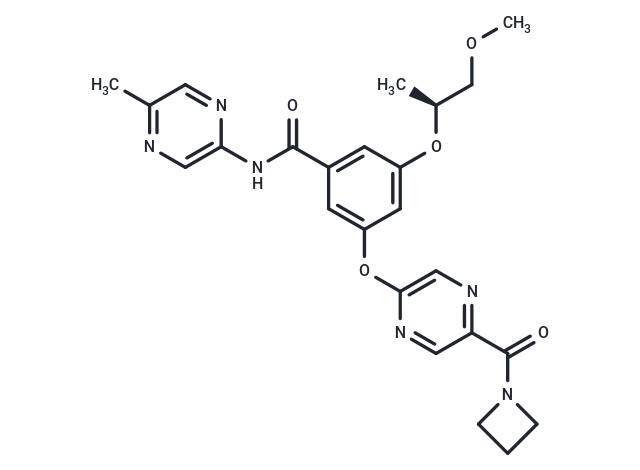Shopping Cart
- Remove All
 Your shopping cart is currently empty
Your shopping cart is currently empty

AZD-1656 is a glucokinase activator (GKA) that can cause dose-limiting hypoglycemia in normal animals used in embryofetal development studies and type 2 diabetes.

| Pack Size | Price | Availability | Quantity |
|---|---|---|---|
| 1 mg | $84 | In Stock | |
| 2 mg | $123 | In Stock | |
| 5 mg | $198 | In Stock | |
| 10 mg | $328 | In Stock | |
| 25 mg | $662 | In Stock | |
| 50 mg | $993 | In Stock | |
| 1 mL x 10 mM (in DMSO) | $216 | In Stock |
| Description | AZD-1656 is a glucokinase activator (GKA) that can cause dose-limiting hypoglycemia in normal animals used in embryofetal development studies and type 2 diabetes. |
| Targets&IC50 | GK:60 nM (EC50) |
| In vivo | The gkdel/wt mouse was used as an alternative rodent strain for embryofetal development studies with AZD-1656. Heterozygous global knockout gkdel/wt females were dosed with 20, 50, or 130 mg/kg/day of AZD-1656 or vehicle for a minimum of 14 consecutive days before mating with wild-type males and throughout organogenesis. Maternal effects were confined to slightly reduced food consumption, reduced body weight gain, and the pharmacologic effect of decreased plasma glucose. Fetuses were genotyped. Fetal weights at the high dose were slightly reduced but there was no effect on fetal survival. There were two specificmajormalformations, omphalocele and right-sided aortic arch, with increased fetal incidence in mid- and high-dose fetuses (e.g., omphalocele fetal incidence of 0.6, 0.7, 4.6, and 2% across the dose groups) plus increased incidences of minor abnormalities and variants indicative of either delayed or disturbed development. Fetal weight and abnormalities were unaffected by fetal genotype. The fetal effects are considered hypoglycemia related. There was no effect on embryofetal survival in the gkdel/wt mouse at AZD-1656 exposures[1]. |
| Alias | AZD 1656 |
| Molecular Weight | 478.5 |
| Formula | C24H26N6O5 |
| Cas No. | 919783-22-5 |
| Smiles | COC[C@H](C)Oc1cc(Oc2cnc(cn2)C(=O)N2CCC2)cc(c1)C(=O)Nc1cnc(C)cn1 |
| Relative Density. | 1.336 g/cm3 (Predicted) |
| Storage | Powder: -20°C for 3 years | In solvent: -80°C for 1 year | Shipping with blue ice. | |||||||||||||||||||||||||||||||||||
| Solubility Information | DMSO: 250 mg/mL (522.47 mM) | |||||||||||||||||||||||||||||||||||
Solution Preparation Table | ||||||||||||||||||||||||||||||||||||
DMSO
| ||||||||||||||||||||||||||||||||||||

Copyright © 2015-2024 TargetMol Chemicals Inc. All Rights Reserved.